Wings of desire: The bird illustrations worth millions
11 July 2018
Beautiful antique volumes of bird illustrations are now among the most valuable books in the world, sometimes selling for millions of pounds. Before Blue Planet, these objects of desire were big business that combined art and science to portray the wonders of the avian world.
John James Audubon's The Birds of America
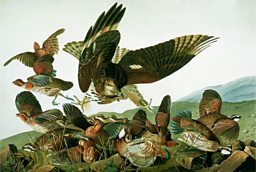
John James Audubon was an ornithologist and painter who was responsible for one of the most important, beautiful and expensive colour plate books ever published. Possibly the greatest bird artist of all, Audubon's The Birds of America was issued in Edinburgh and London between 1827 and 1838.
The book's production cost Aubudon a hundred and fifteen thousand dollars, the equivalent of over two million dollars today.
Audubon's "Great Idea" came in 1820 when he was 35 years old and just out of debtors’ prison in Kentucky. He would use his gift for drawing and affinity for birds to document the species of North America in life-size prints, and thereby restore his dignity and fortune. On countless expeditions, from Florida to Newfoundland, he shot birds with his flintlock gun and hung them on a complex system of wires to render them realistically. The result was 584 spectacular paintings.
The book's production cost Audubon a hundred and fifteen thousand dollars, the equivalent of over two million dollars today. He raised the money himself, leaving his family behind for years at a time and attracting subscribers while lecturing on frontier life in Britain and America. People of means were prepared to pay large sums to satisfy their interest in the natural world; in a sense to 'own' it.
Audubon released prints every couple of months to subscribers on a pay-as-you-go model. The ‘double elephant folio’, which needed two people to turn its pages, took its name from the (67.8 × 101.6 cm) on which it was printed. It became a sensation and was purchased by royalty, statesmen and the leading libraries of Europe and North America.

From the original 200 folios there are 120 known first editions in existence, making it one of the most collectible books in the world. The Economist magazine estimated that five of the ten most expensive sales at book auctions have been for The Birds of America. On 14 June 2018 'The Portland Audubon', described in the prospectus as “among the most superlative copies in private hands of the finest colour-plate book ever produced", at Christie's New York.
Most of the 120 are owned by art galleries and institutions in America and Britain, where there are copies housed at the British Library, Liverpool Central Library and at the Royal College of Physicians and Surgeons in Glasgow. Audubon's legacy lives on in the , a USA-wide conservation organisation with nearly 500 local chapters.


John Gould: The 'Bird Man' of Victorian Britain
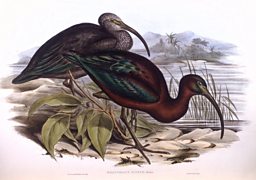
John Gould was Britain's answer to John James Audubon. Although not ranked in the same collectables category as The Birds of America, in May 2018 Sotheby's auction house of Gould's major works at an estimate of £700,000-£900,000. Christie's sold a similar collection in 2008 .
Edward Lear contributed 80 paintings to the lavish books that made Gould a rich man.
Gould worked as a taxidermist for the , and in 1830 saw an opportunity for some private enterprise when he was preparing to exhibit a formidable collection of bird skins which had been sent from the Himalayas.
Gould copied Audubon's subscription model but opted for the new process. Its results were superior to both copper and wood engraving, and allowed for hundreds of prints each capturing the artist's original delicacy and detail. It was a bold and innovative idea, although a young artist called Edward Lear had actually used it first for his own illustrations of parrots.
Edward Lear had an eye for landscapes and an ear for rhyme, but it was as an ornothological artist that he first displayed his prolific talent. He created 80 bird portraits for John Gould, beginning in 1832 when he was just 20 years old. For many, they are the world’s finest ornithological illustrations.
Lear's paintings were intermingled with the work of Gould's wife Elizabeth and other, often less accomplished, artists. He worked for Gould for the next seven years, contributing to the lavish productions which would make Gould a rich man. Ironically, Lear's own A Book of Nonsense is now extremely rare, with one of only eleven complete copies selling for .
One of Lear's biggest fans is naturalist and broadcaster Sir David Attenborough: "Lear’s bird plates, to my eyes at least, rank among the finest of their kind". Attenborough has a prized collection of all of Lear's colour plates, acquired over several decades after he became aware of his work for Gould in 1954.
Gould published books on birds from Britain, Europe, Australia and Papua New Guinea, and also that would soon be lost through human colonization and hunting. He is considered the father of Australian bird study.
Charles Darwin and John Gould
John Gould was also at the forefront of ornithological and evolutionary science. Darwin sent Gould some of the birds collected on the Beagle's second voyage. A five-week stop in the Galápagos Islands had yielded species variously labelled by Darwin as blackbirds, "gross-beaks" and finches.

Gould identified 12 distinct new species of tanager perfectly adapted to their island environments. set the naturalist on the path to researching the transmutation of species and was central to the development of the theory of natural selection.
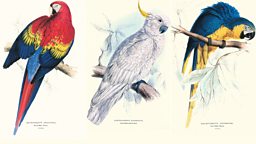

The Nodders: father and son bird painters

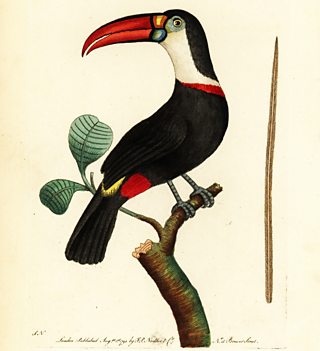
Complete sets of The Naturalist's Miscellany, and even individual volumes, fetch thousands of pounds today.
Frederick Polydore Nodder and his son, Richard, partnered with George Shaw, the zoologist of the British Museum and a fellow of the Royal Society, to produce The Naturalist's Miscellany. It was later assembled into a 24-volume set after being serialised between 1790 and 1813. Shaw provided the text and the scholarship, while the Nodders contributed the superbly hand-colored copperplate etchings.
featured 1,064 illustrations of animals, birds, insects, crustaceans and fish. Complete sets, and even individual volumes . In 2009, a complete 24-volume set sold at auction in London for $31,200.
Frederick P. Nodder honed his draftsmanship working on Captain Cook and Joseph Banks' Florilegium. He was made botanical painter to Queen Charlotte (who was herself a knowledgeable botanist) in 1785.
Following Frederick's death in 1800, his wife Elizabeth is credited as publisher on the Miscellany's subsequent volumes and his son Richard continued with engraving duties. Richard exhibited at the Royal Academy and became botanical painter to King George III.
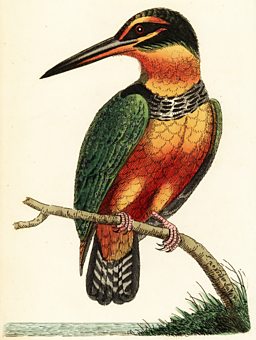

More from Βι¶ΉΤΌΕΔ Arts
-
![]()
Picasso’s ex-factor
Who are the six women who shaped his life and work?
-
![]()
Quiz: Picasso or pixel?
Can you separate the AI fakes from genuine paintings by Pablo Picasso?
-
![]()
Frida: Fiery, fierce and passionate
The extraordinary life of Mexican artist Frida Kahlo, in her own words
-
![]()
Proms 2023: The best bits
From Yuja Wang to Northern Soul, handpicked stand-out moments from this year's Proms




